Mycosis Fungoides: A Clinicopathological Study of 60 Cases from a Tertiary Care Center
- PMID: 32180598
- PMCID: PMC7059469
- DOI: 10.4103/ijd.IJD_602_18
Mycosis Fungoides: A Clinicopathological Study of 60 Cases from a Tertiary Care Center
Abstract
Background: Mycosis fungoides (MF) is the most common primary cutaneous lymphoma. It affects usually the covered areas of the body in elderly males in 6th and 7th decades of life. Atypical dermal lymphoid infiltrate is seen along with epidermotropism. Nuclei of neoplastic cells are convoluted. The neoplastic cells demonstrate positivity for CD3 (Pan T) immunohistochemical stain. Majority show increased CD4 to CD8 ratio. The present study was done to study the clinicopathological features, which might be of help in reaching a correct diagnosis in these cases.
Materials and methods: A retrospective descriptive study was conducted on 60 reported cases of MF. The retrieved slides were reviewed for clinical and histopathological features and immunohistochemical profile.
Results: The ages ranged from 20-84 years, mean age was 47 years. Majority (75%) of patients were male. Trunk and extremities were the sites most commonly affected. There was significant inverse correlation between epidermal thickness and tumor stage (P = 0.02). Thickened epidermis was seen in patch stage and thickness reduced with progressing stage. The intensity of dermal infiltrate and cell size was also statistically significantly linked to stage progression (P < 0.001 each). In addition, proliferation index also correlated significantly with tumor stage (P = 0.002).
Conclusion: Clinical information and histological features are equally important in the accurate diagnosis of MF. Papillary dermal fibrosis is a useful diagnostic clue. CD4:CD8 ratio is not increased in all cases; it may be decreased or remain unchanged.
Keywords: Histologic features; immunohistochemical profile; mycosis fungoides.
Copyright: © 2020 Indian Journal of Dermatology.
Conflict of interest statement
There are no conflicts of interest.
Figures

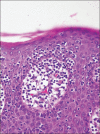
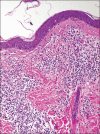
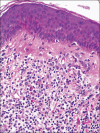


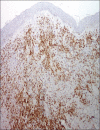
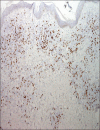
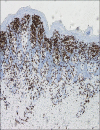
Similar articles
-
Comparison between the histopathological and immunophenotypical features of hypopigmented and nonhypopigmented mycosis fungoides: A retrospective study.J Cutan Pathol. 2021 Apr;48(4):486-494. doi: 10.1111/cup.13882. Epub 2020 Oct 29. J Cutan Pathol. 2021. PMID: 32965737
-
Adult pityriasis lichenoides-like mycosis fungoides: a clinical variant of mycosis fungoides.Int J Dermatol. 2014 Nov;53(11):1331-8. doi: 10.1111/ijd.12135. Epub 2014 Jun 25. Int J Dermatol. 2014. PMID: 24961281
-
Light-microscopic assessment of 100 patients with patch/plaque-stage mycosis fungoides.Am J Dermatopathol. 1988 Dec;10(6):469-77. doi: 10.1097/00000372-198812000-00001. Am J Dermatopathol. 1988. PMID: 3064629 Review.
-
Immunohistochemical analysis of mycosis fungoides on paraffin-embedded tissue sections.Mod Pathol. 1998 Oct;11(10):978-82. Mod Pathol. 1998. PMID: 9796726
-
[Mycosis fungoides in children and adolescents: a report of six cases with predominantly hypopigmentation, along with a literature review].Dermatol Online J. 2012 Mar 15;18(3):5. Dermatol Online J. 2012. PMID: 22483516 Review. Portuguese.
Cited by
-
Cellular Interactions and Inflammation in the Pathogenesis of Cutaneous T-Cell Lymphoma.Front Cell Dev Biol. 2020 Sep 4;8:851. doi: 10.3389/fcell.2020.00851. eCollection 2020. Front Cell Dev Biol. 2020. PMID: 33015047 Free PMC article. Review.
-
Pediatric Mycosis Fungoides Mimicking Benign Dermatoses: A Report of a Rare Case.Am J Case Rep. 2025 Jan 7;26:e945897. doi: 10.12659/AJCR.945897. Am J Case Rep. 2025. PMID: 39774580 Free PMC article.
-
Multidisciplinary Approach to the Diagnosis and Therapy of Mycosis Fungoides.Healthcare (Basel). 2023 Feb 18;11(4):614. doi: 10.3390/healthcare11040614. Healthcare (Basel). 2023. PMID: 36833148 Free PMC article. Review.
-
Decoding Early Mycosis Fungoides: Histopathologic and Immunohistochemical Clues.Cureus. 2024 Apr 3;16(4):e57545. doi: 10.7759/cureus.57545. eCollection 2024 Apr. Cureus. 2024. PMID: 38577165 Free PMC article.
References
-
- Ahn CS, ALSayyah A, Sangüeza OP. Mycosis fungoides: An updated review of clinicopathologic variants. Am J Dermatopathol. 2014;36:933–48. - PubMed
-
- Imam MH, Shenoy PJ, Flowers CR, Phillips A, Lechowicz MJ. Incidence and survival patterns of cutaneous T-cell lymphomas in the United States. Leuk Lymphoma. 2013;54:752–9. - PubMed
-
- Suarez-Varela MM, Gonzalez AL, Vila AM, Bell J. Mycosis fungoides: Review of epidemiological observations. Dermatol. 2000;201:21–8. - PubMed
LinkOut - more resources
Full Text Sources
Research Materials
